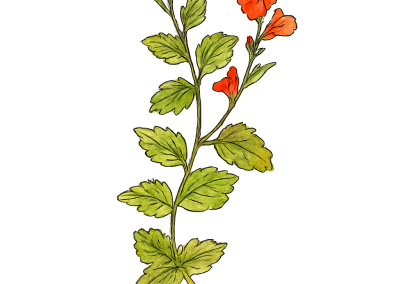Tagetes erecta
Scientific description
Scientific name: Tagetes erecta
Common name: Marigold
Kingdom: Plantae
Phylum (Division): Tracheophyta
Class: Magnoliopsida
Order: Asterales
Family: Asteraceae (Sunflower family)
Genus: Tagetes
Species: Tagetes erecta L.
Origin:
Native to Mexico and Central America. Despite the common name "African Marigold," it is not native to Africa.
Description:
Upright annual 30–100 cm, large pom-pom flowers in yellow, orange, gold. Aromatic pinnate leaves with lance-shaped leaflets. Sturdy ribbed stems. Long bloom season from early summer to autumn.
Propagation:
By seed. Sow indoors 4–6 weeks before last frost or directly outdoors after frost. Germinates quickly; may self-seed in some regions.
Ecology:
Attracts bees, butterflies, beneficial insects. Repels nematodes, whiteflies, aphids. Thrives in full sun, well-drained soil; tolerates poor soils and dry conditions once established.
Uses:
Gardens, borders, containers. Central to Día de los Muertos in Mexico. Used in Hindu rituals and garlands in India. Traditional Mexican and Ayurvedic medicine. Anti-inflammatory, anti-fungal, eye-supporting. Herbal teas, topical applications. Natural food coloring. Lutein extracts used in poultry feed.
ΚΑΤΙΦΕΣ
Βασίλειο: Plantae
Φύλο (διαίρεση): Τραχεόφυτα
Κλάση: Magnoliopsida
Τάξη: Asterales
Οικογένεια: Asteraceae (οικογένεια των ηλιοτρόπιων)
Γένος: Tagetes
Είδη: Tagetes erecta L.
Καταγωγή:
Ενδημικό του Μεξικού και της Κεντρικής Αμερικής. Παρά την ονομασία «African Marigold», δεν είναι ενδημικό της Αφρικής.
Περιγραφή:
Ετήσιο, όρθιο, ύψος 30–100 cm. Μεγάλα πομ-πομ άνθη σε κίτρινο, πορτοκαλί, χρυσό. Αρωματικά, πτερωτά φύλλα με λοβωτά φυλλάρια. Στιβαροί ραβδωτοί βλαστοί. Μακρά ανθοφορία από αρχές καλοκαιριού έως φθινόπωρο.
Πολλαπλασιασμός:
Με σπόρο. Σπείρετε σε εσωτερικούς χώρους 4–6 εβδομάδες πριν από τον τελευταίο παγετό ή εξωτερικά μετά. Βλαστάνει γρήγορα, μπορεί να αυτοσπείρει.
Οικολογία:
Προσελκύει μέλισσες, πεταλούδες και ωφέλιμα έντομα. Απωθεί νηματοειδή σκουλήκια, αλευρώδεις και αφίδες. Ευδοκιμεί σε πλήρη ήλιο, καλά στραγγιζόμενο έδαφος. Ανθεκτικό σε φτωχά και ξηρά εδάφη.
Χρήση:
Κήποι, μπορντούρες, δοχεία. Κεντρικό στους εορτασμούς Día de los Muertos. Χρησιμοποιείται σε ινδουιστικές τελετές και γιρλάντες. Παραδοσιακή ιατρική Μεξικού και Αγιουρβέδα. Αντιφλεγμονώδες, αντιμυκητιασικό, υποστηρίζει όραση. Χρησιμοποιείται σε τσάι και τοπικά. Πέταλα για φυσικό χρώμα τροφίμων. Εκχυλίσματα λουτεΐνης για χρώμα κρόκου στις ζωοτροφές.
Nom scientifique : Tagetes erecta
Nom commun : Rose d’Inde
Règne : Plantae
Embranchement (Division) : Tracheophyta
Classe : Magnoliopsida
Ordre : Asterales
Famille : Astéracées (famille du tournesol)
Genre : Tagetes
Espèce : Tagetes erecta L.
Origine :
Originaire du Mexique et d’Amérique centrale. Malgré le nom « African Marigold », pas originaire d’Afrique.
Description :
Annuelle dressée 30–100 cm, grandes fleurs pompon en jaune, orange, doré. Feuilles pennées aromatiques, folioles lancéolées. Tiges robustes nervurées. Floraison longue de début été à automne.
Propagation :
Par semis, semer en intérieur 4–6 semaines avant les dernières gelées ou en extérieur après. Germination rapide; auto-ensemencement possible.
Écologie :
Attire abeilles, papillons, insectes utiles. Repousse nématodes, aleurodes, pucerons. Plein soleil, sol bien drainé, tolère sols pauvres et sécheresse.
Utilisations :
Jardins, bordures, pots. Día de los Muertos au Mexique. Rituels hindous et guirlandes en Inde. Médecine traditionnelle mexicaine et ayurvédique. Anti-inflammatoire, antifongique, soutien de la vue. Tisanes, applications topiques. Colorant alimentaire naturel. Extraits de lutéine pour alimentation volailles.
Nume științific: Tagetes erecta
Nume comun: Crăița
Regn: Plantae
Încrengătură (Diviziune): Tracheophyta
Clasă: Magnoliopsida
Ordin: Asterales
Familie: Asteraceae (Familia florii-soarelui)
Gen: Tagetes
Specie: Tagetes erecta L.
Origine:
Originară din Mexic și America Centrală. Numele „crăița africană” nu reflectă originea africană, ci popularitatea în horticultura africană.
Descriere:
Anuală robustă, verticală, 30–100 cm. Flori mari tip pom-pom, galben, portocaliu, auriu. Frunze aromatice penate, frunzulițe lanceolate. Tulpini verzi, rigide și nervurate. Înflorește din începutul verii până toamna.
Propagare:
Prin semințe. Se seamănă în interior 4–6 săptămâni înainte de ultimul îngheț sau afară după. Germinație rapidă; poate să se autoreplice prin semințe.
Ecologie:
Atrage albine, fluturi, insecte benefice. Respinge nematozi, păduchi albi și afide. Preferă soare plin, sol bine drenat, toleranță la soluri sărace și secetă.
Utilizare:
Grădini, garduri vii, ghivece. Día de los Muertos în Mexic. Ritualuri hinduse și ghirlande festive în India. Medicină tradițională mexicană și ayurvedică. Anti-inflamator, antifungic, susține vederea. Ceaiuri medicinale, aplicații topice. Petale ca colorant alimentar. Extracte de luteină pentru hrana păsărilor.
Creative writing inspired by Tagetes erecta
Tagetes erecta — Katifea
In a distant village, there lived a young maiden named Katifea, known for her golden beauty and radiant heart. She was loved by all for her kindness and her ability to bring joy to those around her. Katifea had a special garden that she tended with great care, filled with vibrant flowers of every color. But among all the blossoms, her favorite was a tall, golden flower that shone as brightly as the sun—the marigold.
One day, the god Apollo, attracted by her radiant garden, descended from Mount Olympus to visit her. He was so taken by Katifea’s beauty and the brilliance of her golden flowers that he asked her to join him as his companion. However, Katifea cherished her simple life on Earth and humbly declined Apollo’s offer.
Apollo, though hurt by her refusal, respected her wishes. As a gift of farewell, he blessed her garden and her beloved flowers, turning them into a symbol of light and protection. The marigolds, now known as Tagetes erecta, were endowed with golden petals that mirrored the sun itself, bringing warmth and light to those who cared for them.
Over time, the people began to call the flowers Κατιφέδες, in honor of the maiden Katifea who had brought so much light into their lives. They believed that marigolds had the power to protect against evil, and they would plant them in their gardens to bring good fortune and prosperity. The flower became a symbol of devotion, purity, and the enduring connection between the Earth and the heavens.







